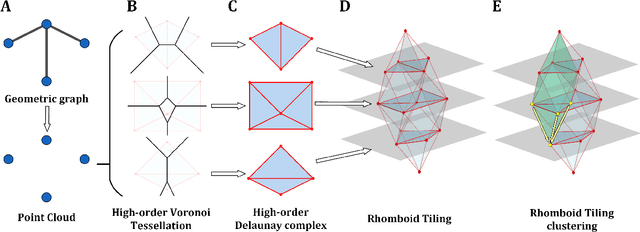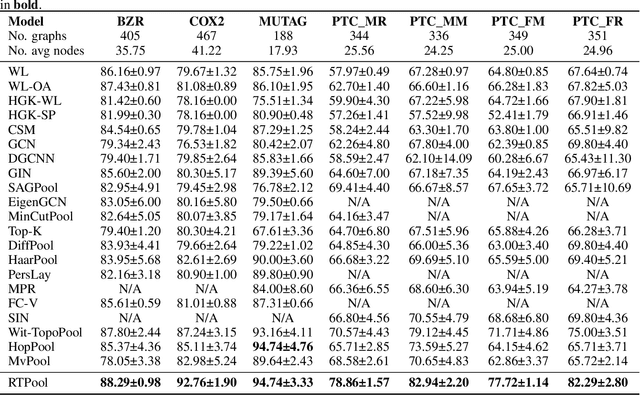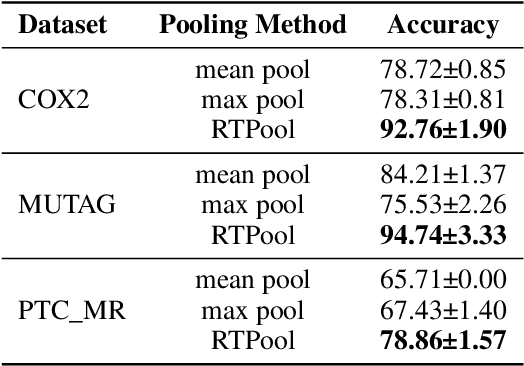Longlong Li
Beyond Node Attention: Multi-Scale Harmonic Encoding for Feature-Wise Graph Message Passing
May 21, 2025Abstract:Conventional Graph Neural Networks (GNNs) aggregate neighbor embeddings as holistic vectors, lacking the ability to identify fine-grained, direction-specific feature relevance. We propose MSH-GNN (Multi-Scale Harmonic Graph Neural Network), a novel architecture that performs feature-wise adaptive message passing through node-specific harmonic projections. For each node, MSH-GNN dynamically projects neighbor features onto frequency-sensitive directions determined by the target node's own representation. These projections are further modulated using learnable sinusoidal encodings at multiple frequencies, enabling the model to capture both smooth and oscillatory structural patterns across scales. A frequency-aware attention pooling mechanism is introduced to emphasize spectrally and structurally salient nodes during readout. Theoretically, we prove that MSH-GNN approximates shift-invariant kernels and matches the expressive power of the 1-Weisfeiler-Lehman (1-WL) test. Empirically, MSH-GNN consistently outperforms state-of-the-art models on a wide range of graph and node classification tasks. Furthermore, in challenging classification settings involving joint variations in graph topology and spectral frequency, MSH-GNN excels at capturing structural asymmetries and high-frequency modulations, enabling more accurate graph discrimination.
Rhomboid Tiling for Geometric Graph Deep Learning
May 14, 2025



Abstract:Graph Neural Networks (GNNs) have proven effective for learning from graph-structured data through their neighborhood-based message passing framework. Many hierarchical graph clustering pooling methods modify this framework by introducing clustering-based strategies, enabling the construction of more expressive and powerful models. However, all of these message passing framework heavily rely on the connectivity structure of graphs, limiting their ability to capture the rich geometric features inherent in geometric graphs. To address this, we propose Rhomboid Tiling (RT) clustering, a novel clustering method based on the rhomboid tiling structure, which performs clustering by leveraging the complex geometric information of the data and effectively extracts its higher-order geometric structures. Moreover, we design RTPool, a hierarchical graph clustering pooling model based on RT clustering for graph classification tasks. The proposed model demonstrates superior performance, outperforming 21 state-of-the-art competitors on all the 7 benchmark datasets.
Atten-Transformer: A Deep Learning Framework for User App Usage Prediction
Feb 24, 2025Abstract:Accurately predicting smartphone app usage patterns is crucial for user experience optimization and targeted marketing. However, existing methods struggle to capture intricate dependencies in user behavior, particularly in sparse or complex usage scenarios. To address these challenges, we introduce Atten-Transformer, a novel model that integrates temporal attention with a Transformer network to dynamically identify and leverage key app usage patterns. Unlike conventional methods that primarily consider app order and duration, our approach employs a multi-dimensional feature representation, incorporating both feature encoding and temporal encoding to enhance predictive accuracy. The proposed attention mechanism effectively assigns importance to critical app usage moments, improving both model interpretability and generalization. Extensive experiments on multiple smartphone usage datasets, including LSapp and Tsinghua App Usage datasets, demonstrate that Atten-Transformer consistently outperforms state-of-the-art models across different data splits. Specifically, our model achieves a 45.24\% improvement in HR@1 on the Tsinghua dataset (Time-based Split) and a 18.25\% improvement in HR@1 on the LSapp dataset (Cold Start Split), showcasing its robustness across diverse app usage scenarios. These findings highlight the potential of integrating adaptive attention mechanisms in mobile usage forecasting, paving the way for enhanced user engagement and resource allocation.
Make-A-Character 2: Animatable 3D Character Generation From a Single Image
Jan 15, 2025



Abstract:This report introduces Make-A-Character 2, an advanced system for generating high-quality 3D characters from single portrait photographs, ideal for game development and digital human applications. Make-A-Character 2 builds upon its predecessor by incorporating several significant improvements for image-based head generation. We utilize the IC-Light method to correct non-ideal illumination in input photos and apply neural network-based color correction to harmonize skin tones between the photos and game engine renders. We also employ the Hierarchical Representation Network to capture high-frequency facial structures and conduct adaptive skeleton calibration for accurate and expressive facial animations. The entire image-to-3D-character generation process takes less than 2 minutes. Furthermore, we leverage transformer architecture to generate co-speech facial and gesture actions, enabling real-time conversation with the generated character. These technologies have been integrated into our conversational AI avatar products.
KA-GNN: Kolmogorov-Arnold Graph Neural Networks for Molecular Property Prediction
Oct 15, 2024Abstract:Molecular property prediction is a crucial task in the process of Artificial Intelligence-Driven Drug Discovery (AIDD). The challenge of developing models that surpass traditional non-neural network methods continues to be a vibrant area of research. This paper presents a novel graph neural network model-the Kolmogorov-Arnold Network (KAN)-based Graph Neural Network (KA-GNN), which incorporates Fourier series, specifically designed for molecular property prediction. This model maintains the high interpretability characteristic of KAN methods while being extremely efficient in computational resource usage, making it an ideal choice for deployment in resource-constrained environments. Tested and validated on seven public datasets, KA-GNN has shown significant improvements in property predictions over the existing state-of-the-art (SOTA) benchmarks.
Multi-Scale Deformable Transformers for Student Learning Behavior Detection in Smart Classroom
Oct 10, 2024Abstract:The integration of Artificial Intelligence into the modern educational system is rapidly evolving, particularly in monitoring student behavior in classrooms, a task traditionally dependent on manual observation. This conventional method is notably inefficient, prompting a shift toward more advanced solutions like computer vision. However, existing target detection models face significant challenges such as occlusion, blurring, and scale disparity, which are exacerbated by the dynamic and complex nature of classroom settings. Furthermore, these models must adeptly handle multiple target detection. To overcome these obstacles, we introduce the Student Learning Behavior Detection with Multi-Scale Deformable Transformers (SCB-DETR), an innovative approach that utilizes large convolutional kernels for upstream feature extraction, and multi-scale feature fusion. This technique significantly improves the detection capabilities for multi-scale and occluded targets, offering a robust solution for analyzing student behavior. SCB-DETR establishes an end-to-end framework that simplifies the detection process and consistently outperforms other deep learning methods. Employing our custom Student Classroom Behavior (SCBehavior) Dataset, SCB-DETR achieves a mean Average Precision (mAP) of 0.626, which is a 1.5% improvement over the baseline model's mAP and a 6% increase in AP50. These results demonstrate SCB-DETR's superior performance in handling the uneven distribution of student behaviors and ensuring precise detection in dynamic classroom environments.
Photovoltaic Panel Defect Detection Based on Ghost Convolution with BottleneckCSP and Tiny Target Prediction Head Incorporating YOLOv5
Mar 02, 2023



Abstract:Photovoltaic (PV) panel surface-defect detection technology is crucial for the PV industry to perform smart maintenance. Using computer vision technology to detect PV panel surface defects can ensure better accuracy while reducing the workload of traditional worker field inspections. However, multiple tiny defects on the PV panel surface and the high similarity between different defects make it challenging to {accurately identify and detect such defects}. This paper proposes an approach named Ghost convolution with BottleneckCSP and a tiny target prediction head incorporating YOLOv5 (GBH-YOLOv5) for PV panel defect detection. To ensure better accuracy on multiscale targets, the BottleneckCSP module is introduced to add a prediction head for tiny target detection to alleviate tiny defect misses, using Ghost convolution to improve the model inference speed and reduce the number of parameters. First, the original image is compressed and cropped to enlarge the defect size physically. Then, the processed images are input into GBH-YOLOv5, and the depth features are extracted through network processing based on Ghost convolution, the application of the BottleneckCSP module, and the prediction head of tiny targets. Finally, the extracted features are classified by a Feature Pyramid Network (FPN) and a Path Aggregation Network (PAN) structure. Meanwhile, we compare our method with state-of-the-art methods to verify the effectiveness of the proposed method. The proposed PV panel surface-defect detection network improves the mAP performance by at least 27.8%.
 Add to Chrome
Add to Chrome Add to Firefox
Add to Firefox Add to Edge
Add to Edge